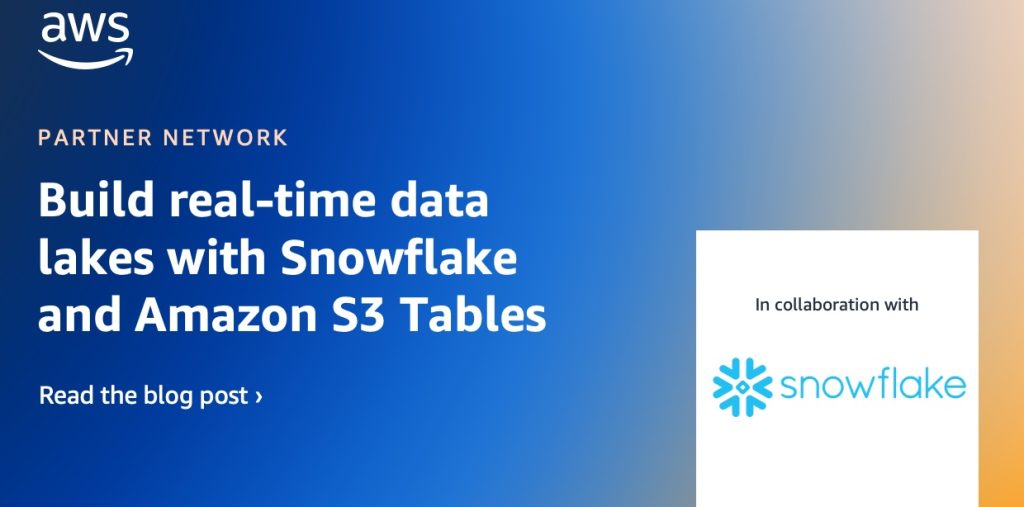AWS Partner Network (APN) Blog
Category: Amazon Kinesis
Build real-time data lakes with Snowflake and Amazon S3 Tables
Learn how to build scalable, real-time data lakes by combining Amazon S3 Tables with Snowflake integration. This solution enables efficient streaming data ingestion and analysis while automatically managing table optimization and maintenance. Discover how manufacturing companies can leverage this architecture to transform IoT sensor data into actionable insights, combining operational analytics with predictive maintenance capabilities. The integration between S3 Tables and Snowflake, along with SageMaker Lakehouse’s Iceberg REST endpoint, creates a robust foundation for streaming analytics that can handle high-volume data streams while maintaining performance and security.
Event-driven Composable CDP Architecture Powered by Snowplow and Databricks
As customer expectations evolve and data volumes grow exponentially, organizations face unprecedented challenges in managing and activating customer data effectively. Snowplow, a behavioral data collection platform, combined with Databricks Lakehouse platform, creates a scalable foundation for building a next-generation composable CDP on AWS. This solution enables organizations to collect, process, and activate customer data at scale while maintaining complete data ownership and control.
Next-Gen Patient Monitoring with Vivalink’s Intelligent Biometrics Platform and AWS
The challenge for clinicians involves the secure management and analysis of patient data from various medical sensors and monitoring devices. Learn how Vivalink’s Biometrics Data Platform on AWS is transforming patient care through secure, scalable, and intelligent biometric data management.
Personalize Amazon Connect customer interactions in real-time using Tealium and AI
Discover how integrating Tealium CDP with Amazon Connect transforms customer service by bringing real-time digital journey insights directly to your contact center. Understand a reference architecture for seamlessly incorporating customer behavior data from web, mobile, and connected devices into Amazon Connect. See how this integration empowers agents with contextual intelligence, reduces resolution times, and delivers hyper-personalized experiences that drive customer satisfaction.
Elevating Call Center performance using Amazon Connect and Amazon Bedrock
The Agent AI Ally solution revolutionizes call center operations by harnessing generative AI to provide agents with real-time, contextual support and product information during customer interactions. Powered by Anthropic’s Claude 3.5 Sonnet model through Amazon Bedrock, the solution delivers instant insights and suggestions while analyzing customer responses in real-time. This comprehensive platform integrates key AWS services including Amazon Connect, Transcribe, and Kendra to create a powerful system that enhances agent performance and customer satisfaction through AI-driven assistance and efficient data processing
How TCS unlocked Open Banking with Amazon Kinesis Data Streams
TCS partnered with a leading Australian bank to implement Consumer Data Right (CDR) compliance through an open banking solution, enabling secure data sharing for 400,000+ customers while maintaining existing banking operations. The solution architecture leverages AWS services including Amazon Kinesis Data Streams, AWS DMS, Data Firehose, Glue, and Aurora MySQL to process 6 million records daily in real-time, with comprehensive security controls and 99.99% uptime. The implementation demonstrates TCS’s expertise in creating scalable, secure enterprise data platforms that enable financial institutions to modernize their data streaming capabilities while protecting core operations and meeting regulatory requirements.
Scaling AWS multi-region and account logs delivery to Grafana Cloud
This blog post explores a scalable architecture for centralized log monitoring in multi-region, multi-account AWS environments. The proposed solution leverages AWS CloudWatch account-level subscription filters to efficiently deliver logs from various sources to Grafana Cloud, a unified platform for log analysis, visualization, and alerting. By consolidating logs from disparate sources, organizations can gain improved visibility, streamline troubleshooting, enhance security and compliance, and optimize performance across their cloud infrastructure. The article provides a detailed overview of the architecture, highlighting the benefits of this approach and guiding readers on implementing this scalable log delivery solution.
Achieve near real-time analytics on Amazon DynamoDB with SingleStore
By combining Amazon DynamoDB with SingleStore, organizations can efficiently capture, process, and analyze DynamoDB data at scale. SingleStore has high-throughput data ingestion and near-real time analytical query capability for both relational and JSON data. This integration empowers businesses to derive actionable insights from their data in near real time, enabling faster decision-making and improved operational efficiency.
Unlocking The Next-Gen Digital Analytics Solution, Powered by Snowplow and Snowflake on AWS
Learn more about the Next-Gen Digital Analytics, a solution built on Amazon Web Services, using Snowplow and Snowflake. This joint solution empowers organizations to unlock the untapped value of customer behavioral data. It improves data quality, governance, and real-time activation within their AWS environment. By implementing this solution, customers can supercharge the use of Artificial Intelligence (AI) and generative AI adoption to help address key business objectives, such as user acquisition, retention, and customer lifetime value.
Revolutionize data landscape with HCLTech’s Intelligent Ingestion solution for rapid ETL and beyond
HCLTech’s Intelligent Ingestion solution provides automated low-code to no-code approach, simplifying ETL build efforts for both batch and real-time data ingestion workloads. It is built using rich set of AWS services like AWS Step Functions, AWS Glue, AWS Glue DataBrew, AWS Lambda, AWS Lake Formation, Amazon Kinesis, Amazon S3, Amazon Simple Notification Service (SNS), etc., among other services to achieve seamless data integration, transformation and quality assurance. This solution entirely automates ETL ingestion upon a single click (event trigger) and provides reusable ETL workflows for rapid ETL development. It also brings quick actionable insights and decision making into business.









